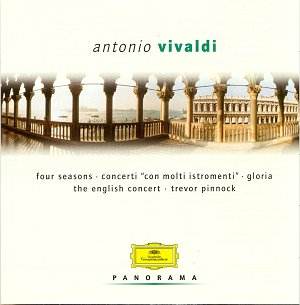VIVALDI
The Four Seasons ;
Gloria RV 589 ;
Concerto for two violins and two cellos RV 575 ;
Concerto for two mandolins RV 532 ;
Concerto for oboe and violin RV 548 ;
Flute Concerto (La Notte) RV439 ;
Concerto for strings RV 151
Concerto for four violins RV 549 ;
Bassoon Concerto RV 484 ;
Concerto " con inolti istroments" RV 558
.
 The English Consort, Trevor
Pinnock
The English Consort, Trevor
Pinnock
Recordings made between 1982 and 1995
 DG Panorama 469 220-2.
(2 CDs) Bargain
price.
DG Panorama 469 220-2.
(2 CDs) Bargain
price.
Crotchet

This is another great bargain eight concertos plus the four violin concertos
that make up The Seasons and that wonderful masterpiece, the Gloria
in D.
Bad perfomances can deter one's interest
and enthusiasm in a work. When I heard Nigel Kennedy's recorded performance
of The Seasons I was very dispirited and how that recording won awards
I cannot say. It had all the marks of a mannered, unstylistic rendering.
Then I saw the work turned into a ballet and the visual images which the
dancers produced destroyed the character of the work. It is true that
associations with a particular piece of music can devalue and depreciate
it. Carmina Burana has for ever been damaged by the advertisement
for Old Spice and the New World Symphony by Hovis Bread and the honourable
working-class image ; Nessun Dorma is now associated with 22 men kicking
a ball around and so on. Vivaldi's Seasons now conjures up ballerinas
as trees and lusty men throwing nubile females about thus making Vivaldi's
score to become degenerate as a sexy, modern piece..... which it is
not.
Simon Standage is the reliable soloist here. He does not exaggerate or caricurate
but plays the music straight and clearly. Pinnock's acompaniment is perfect
without clumping bass lines or affectation. There is some very good interplay
between the soloist and the orchestra as, for example, in the slow movement
of the E major concerto known as Spring. It is this unfussy intimacy
in Pinnock's perforniances that I so admire. The Dance Pastorale finale
is possibly slightly understated and a trifle slow but it makes for a clarity
and subdued energy. And what grace and elegance! One thought of Mendlessohn!
The second concerto, Summer, has a curious introduction but when the
allegro begins we have this repetitive motif and the music varies in tempo
as if one is trying to run on a summer's day and then has to stop. Musically,
it is unsatisfactory and the bird-song imitations may have inspired Messaien.
The changing mood problem carries over to the second movement in which the
lower strings seem to give a suggestion of distant thunder. The presto
finale fizzes, for the most part, like champagne.
Autumn may be the least self-indulgent of the concertos. But, again, it is
programme music and harks back to the Spring movement. It is also
a moody piece. It never settles but then that's the weather for you! But
Vivaldi did not live in England! Do Italians greet each other in the street
and say, "Nice day, isn't it?" The first movement does break down and there
is a passage in which I visualise some children looking out of a window being
very forlorn as they cannot go out to play because of the weather. The adagio
is quite beautiful in this performance. The finale harks back to that
signature-tune style. Here, Standage gives
some crisp and admirable playing.
The final concerto, Winter. is just as odd.
Do we have to visualise skaters on a pond heavily dressed with mufflers et
al? Or is it that we English always think of the frozen Thames in this
concerto'?
I would have liked a greater attack and a little brisker tempo in the opening
movement . But it is so well played. I expect
winter to be more angry. After all, it is the most exciting season of the
year even if the least popular. The raw cold is exquistely captured by Standage
in the largo very well done. And do you hear the orchestral raindrops? Very
effective! Chopin, take note. The finale has a hesitant start and collapses
in the middle.
This is not, in my opinion, great music but somewhat eccentric music.
The Gloria is a wonderful piece and, as someone remarked, "Thirty
minutes of Heaven." This performance has rhythmic drive and vitality. It
simple utterance is sublime. How well Pinnock captures the majestic worship
of the Divine. The choral singing is a delight. This is that rare type of
music where you want to get up and sing and it has a spiritual dimension
that has the capacity to bring tears to the eyes and rouse all those good
emotions and subdue any base ones. The purists will criticise me for suggesting
the emotive quality of baroque music but that is what it has. Some of the
sequences in Et in terra pax hominibus are so lovely in this
recording that I was transported to a better world. This is very special
music in a very special perfomance. Convincing, moving, rewarding, rare and
totally glorious. Music of real class given a performance that does it justice.
Even the birds outside my study window have joined in. The soloisits, Jennifer
Smith and Nancy Argenta (sopranos) and Catherine Wyn-Rogers (contralto) are
very good. There are some unsurpassed moments in the Laudamus
te. The spell-binding oboe solo in Domine Deus is simply
gorgeous.
I have said enough about this masterpiece.
The second CD consists of eight miscellaneous concertos. The Concerto
for Four Violins is not the more familar one in B minor but one in
D major. The B minor is a gem and I wish it were on this recording. The RV
575 concerto has a super largo and the Flute Concerto is
rewarding.
Who was it that said that Vivaldi wrote one concerto but modified it 500
times?
David Wright
Performances

Recording

